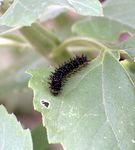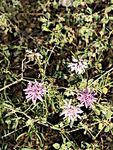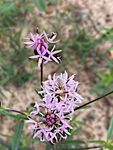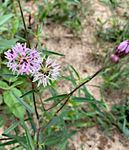What's Growing On? BASTROP COUNTY MASTER GARDENER ASSOCIATION - Texas Master Gardener Association
←
→
Page content transcription
If your browser does not render page correctly, please read the page content below
What’s Growing On?
BASTROP COUNTY MASTER GARDENER ASSOCIATION
June 2021
Mosquito Repellents Palafoxia – An overlooked Texas Native
By Carolyn Turman
By Wizzie Brown
I saw a beautiful little plant last fall
Mosquitoes are out in masses and since they are hiding under the branches of a mes-
capable of disease transmission, it is important quite bush and took the pictures be-
that you protect yourself when spending time low. I think this is a Palafoxia callosa
outside. Of course, you can wear long pants and (picture at left). Palafoxia is a Texas
a long-sleeved shirt in light colors to reduce the native and part of the Asteraceae fam-
number of mosquitoes that can reach your skin ily. It is an annual that reseeds.
when outside, but this is not always the option
people choose with temperatures on the rise. An- This spring while waiting for
other option to protect yourself is repellent. them to emerge in the same
place, I saw more in a mead-
Repellent should only be applied to clothing and ow near Buescher State Park.
exposed skin; do not apply repellent underneath The ones in the meadow have
clothing! If you want to apply repellent to your been identified as Palafoxia
face, spray your hands with repellent and rub it rosea (picture at right). Alt-
onto your face. Do not spray repellent directly hough they look the same
into your face or near eyes or mouth. Make sure from a distance, there are
to apply repellent outdoors. Do not allow chil- subtle differences. According to the data in Flora
dren to handle repellents and seek advice from a of North America, (www.eflores.org), P. callosa
physician regarding insect repellent use for chil- phyllaries (bracts) are a bit narrower than P.
dren under two years of age. Wash hands before rosea. This difference in the flowers indicates
eating, smoking, or using the restroom. that they are two different species.
To reduce disease transmission from mosquitoes, According to the information on the Lady Bird
the Center for Disease Control (CDC) recom-
mends using a product registered with the EPA
(Continued on page 3)
(Environmental Protection Agency) containing
one of the following active ingredients: DEET,
picaridin, IR3535, oil of lemon eucalyptus Inside this issue:
(OLE), para-methane-diol (PMD), or 2-
undecanone. DEET, also known N, N-diethyl-m-
toluamide or N, N-diemethylbenzamide, was de-
veloped by the U.S. Army in 1946 to protect sol- Mosquito Repellents (continued) 2
diers in insect-infested areas. Pesticides contain-
ing DEET have been used by the public since
Palafixia (continued) 3
Larval Host Plants 4–5
(Continued on page 2)(Continued from page 1)
1957. Products containing DEET should not be used on children younger than 2 months of age (read
the label and check with your pediatrician if you have questions). DEET has a slight odor and may
have a greasy feel to some people. It may damage plastic, rubber, vinyl, or synthetic fabrics. DEET
may be irritating to the eyes and skin for some people and comes in a wide variety of concentrations,
so choose one that will work best for your situation.
Picaridin was first made in the 1980’s and resembles a natural compound called piperine (which is
found in plants used to produce black pepper). Picaridin has been used in Europe and Australia for
many years but has only been in the U.S. since 2005. Picaridin is non-greasy and odorless.
IR-3535, or 3-[N-Butyl-N- acetyl]-aminopropionic acid, ethyl ester, was developed in the mid-
1970’s and became registered for use in the U.S. in 1999. It is registered as a biopesticide by the EPA
because it is functionally identical to a naturally occurring substance (an amino acid). It may dissolve
or damage plastics and may be irritating to the eyes.
Oil of lemon eucalyptus (OLE) and PMD (para-menthane-3,8-diol) are essentially the same thing;
PMD is the synthesized (lab created) version of oil of lemon eucalyptus. “Pure” or “essential” oil of
lemon eucalyptus is not labeled as a repellent and has not undergone testing and should not be used
as a repellent product. OLE/PMD has been on the market in the U.S. since 2002. OLE/PMD should
not be used on children younger than 3 years of age. The natural product (OLE) has known allergens
within it while the synthetic version (PMD) has less of a risk to allergens. This product is classified
as a biopesticide. OLE/PMD has a varying range of residual effectiveness, some offering about 20
minutes of protection while other products may last up to two hours.
The product 2-undecanone is also known as methyl nonyl ketone or IBI-246. It is a colorless oil that
can either be produced synthetically or extracted from plants such as rue, cloves, ginger, strawber-
ries, or wild grown tomatoes. This product is fairly new.
Many factors play into how long a repellent will last for a person. Some of these are:
• The concentration (or percent of active ingredient) of the product. You can find the percentage on
the product label.
• Person’s attractiveness. Some people are more attractive to mosquitoes than others (and no scien-
tific research has proven that it is because of eating garlic, taking vitamin B, using tobacco products,
etc.). A person’s genetic code plays a large part on what makes a person so attractive to mosquitoes.
• Frequency and uniformity of application. In other words, how often is the repellent applied and
how good of coverage did you get?
Activity level of the person. The more active the person is, the more sweat they produce which can
cause the repellent to wash off the surface of the skin.
(Continued on page 3)
Volunteering
Master Gardeners volunteer in the community to teach others about horticulture. We follow the re-
search-based recommendations of Texas A&M AgriLife Extension. Members who complete 50 hours
of volunteer service in the year after training earn the designation “Texas Master Gardener.” We use
our title only when engaged in Texas A&M AgriLife Extension activities.
2(Continued from page 2) (Continued from page 1)
As a word of caution, there are products that Johnson Wildflower website,
combine sunscreen and insect repellent. The (www.wildflower.org), P. callosa grows in lime-
CDC recommends that if you need sunscreen stone glades; bald knobs; open, sandy areas; and
and repellent, that you choose two separate along gravelly stream edges. It is drought tolerant,
products. Sunscreen should be applied more of- likes full sun and blooms from August to Novem-
ten than repellents. ber.
For more information or help with identifica-
tion, contact Wizzie Brown, Texas AgriLife Ex- P. callosa at left; P. rosea at
tension Service Program Specialist at right
512.854.9600. Check out my blog at www.urban
-ipm.blogspot.com The Lady Bird Johnson website information on P.
This work is supported by Crops Protection and rosea indicated that it is normally found in prai-
Pest Management Competitive Grants Program ries, plains, meadows and pastures and grows in
[grant no. 2017-70006-27188 /project accession many different types of soil from sandy to caliche.
no. 1013905] from the USDA National Institute It prefers partial shade and blooms June to Octo-
of Food and Agriculture. ber.
I wanted to introduce you to this plant since it is a
The information given herein is for educational native plant that would be great in butterfly gar-
purposes only. Reference to commercial prod- dens. Be on the look out and find some seeds. La-
ucts or trade names is made with the under- dy Bird Wildflower center suggests collecting
standing that no discrimination is intended and seed in October and November and plant in De-
no endorsement by Texas A&M AgriLife Exten- cember or January. Please don’t take them all, as
we want nature to be able to reseed as well. This is
sion Service or the Texas A&M AgriLife Research
an amazing little plant.
is implied.
“Palafoxia callosa.” Flora of North America. Accessed June 12,
The Texas A&M AgriLife Extension Service pro- 2021
vides equal access in its programs, activities, ed- http://www.efloras.org/florataxon.aspx?
flora_id=1&taxon_id=242416916
ucation and employment, without regard to
race, color, sex, religion, national origin, disabil- “Palafoxia rosea.” Flora of North America. Accessed June 12,
2021
ity, age, genetic information, veteran status,
http://www.efloras.org/florataxon.aspx?
sexual orientation or gender identity. flora_id=1&taxon_id=250067282
Palafoxia callosa.” Lady Bird Johnson Wildflower Center. Ac-
cessed June 12 2021
https://www.wildflower.org/plants/result.php?id_plant=PACA3
“Palafoxia rosea” Lady Bird Johnson Wildflower Center. Ac-
cessed June 12, 2021.
https://www.wildflower.org/plants/result.php?id_plant=PARO
New Website Features
Check out our website, which features project slideshows, a new photo gallery section, and an events
calendar to check out upcoming activities. Find news articles and our newsletters. Thanks to Dave
Posh for keeping the info timely for us https://txmg.org/bastropcounty/
3Larval Host Plants: Completing the Circle
By Howard Nemerov
If you grow nectar plants, you’ll attract butterflies. If you provide food for their offspring, butterflies
will call your garden home.
Pipevine Swallowtail
For years, Pipevine Swallowtail (Battus philenor) has been enjoying
nectar from annuals in the Aster family, mostly Zinnia elegans
(California Giants Zinnia) and Tithonia rotundifolia (Mexican Sun-
flower). As per their name, this Swallowtail species is monopha-
gous: their larvae feed only on certain Pipevine (Aristolochia) spe-
cies.1 For example, Xerxes Society notes that Pipevine larvae can-
not feed on tropical species like Aristolochia gigantea.2 North Caro-
lina Extension goes further, stating that Pipevine larvae will die
within 3 days after consuming Aristolochia gigantea leaves.3 While
tropical vines like this may wow the human eye, they present a
threat to native butterflies.
There is a Bastrop County native Pipevine, Aristolochia erecta, a misnomer if ever there was: While this
plant can get long like a vine, it’s hardly “erect” but trails along the ground as a grass mimic,
“presumably to evade female Pipevine swallowtail butterflies looking for a good place to lay their
eggs.”4
Fortunately, Aristolochia fimbriata, though native to South America, is a
suitable host for Pipevine Swallowtail larva.5 Considered a groundcover,
it produces a low mound that spreads 2–3 feet. Along with white-veined,
heart-shaped leaves, it’s a pleasing landscape element that enhances pol-
linator gardens. I obtained seeds from a Central Texas gardener and
planted this perennial in a location receiving direct morning sun.
In the picture to the right, there are at least 3 larvae happily munching
away. By maturity, they had eaten all five plants to the ground. Fortu-
nately, Aristolochia fimbriata has a fleshy taproot, and the plants have
since regenerated, looking better than ever. I hope to save seed and plant
more next year, to ensure sufficient larval hosting without over-stressing a few plants.
Silvery Checkerspot
Silvery Checkerspot (Chlosyne nycteis) began visiting after I intro-
duced Bastrop native Verbesina encelioides (Cowpen Daisy) into my
garden (both on left). Larva are polyphagous, feeding on a number of
genera in the Aster family.6 The University of South Florida confirms
that Silvery Checkerspot caterpillars feed on Echinacea purpurea.7
I’m trialing a new Echinacea hybrid this year called “Cheyenne Spir-
it” which has E. purpurea ancestry.8 I found a cluster of recently-
hatched Silvery Checkerspot larvae consuming on of the #1 plants in
an isolated corner of the garden. These hungry babies were too small
(Continued on page 5)
4(Continued from page 4)
to migrate, so I moved the pot beneath an established sunflower (Helianthus
annuus). By the next day, the larva had migrated to the sunflower (right).
Meanwhile, on the Cowpen Daisy, I also found
young Silvery Checkerspot larvae the same day
(left). All three plants are in the Aster family,
underscoring this butterfly’s ability to survive
on a number of taxonomically-related plant spe-
cies.
Since they consumed the Cheyenne Spirit plant,
it’s good to know that my garden has plenty of
options for this butterfly. This benefits plants
too, spreading the banquet around so that fewer
plants end up having to regenerate from the roots like the poor young Echinacea.
Cowpen Daisy naturalized in my yard this year, and Silvery Checkerspot butter-
flies followed suit, laying eggs on it as well as enjoying its nectar. One benefit
that only native annuals can provide is attracting native butterflies. While many
pollinators enjoy flowers like zinnias, only natives offer season-long attraction
of nectar and larval hosting. Cowpen Daisy has made a home here, and so has
Silvery Checkerspot (right).
Initially, it may be challenging to accept disappearing leaves on your prized
flowers and perennials. Caterpillars need to eat a lot to successfully pupate. With
a little management and preparation, Nature eventually finds a balance, and your
garden will provide a longer-lasting dance of these winged jewels.
Endnotes
1
“Pipevine Swallowtail.” Butterflies and Moths of North America. Accessed June 25, 2021. https://
www.butterfliesandmoths.org/species/Battus-philenor
2
“Gardening for Butterflies: How You Can Attract and Protect Beautiful, Beneficial Insects.” Xerxes Society. Timber Press,
2016.
3
“Aristolochia gigantea.” North Carolina Extension Gardener Plant Toolbox. Accessed June 25, 2021. https://
plants.ces.ncsu.edu/plants/aristolochia-gigantea/
4
“Aristolochia erecta.” Lady Bird Johnson Wildflower Plant Center. Accessed June 25, 2021. https://www.wildflower.org/
plants/result.php?id_plant=ARER
5
“Aristolochia fimbriata.” North Carolina Extension Gardener Plant Toolbox. Accessed June 25, 2021. https://
plants.ces.ncsu.edu/plants/aristolochia-fimbriata/
6
“Silvery Checkerspot.” Butterflies and Moths of North America. Accessed June 25, 2021. https://www.butterfliesandmoths.org/
species/Chlosyne-nycteis
7
“Silvery Checkerspot.” Alabama Butterfly Atlas. Accessed June 22, 2021. https://alabama.butterflyatlas.usf.edu/species/
details/40/silvery-checkerspot
8
“Echinacea Cheyenne Spirit.” PanAmerican Seed. Accessed January 25, 2021. https://patft.uspto.gov/netacgi/nph-Parser?
Sect1=PTO1&Sect2=HITOFF&d=PALL&p=1&u=%2Fnetahtml%2FPTO%
2Fsrchnum.htm&r=1&f=G&l=50&s1=7,982,110.PN.&OS=PN/7,982,110&RS=PN/7,982,110
5You can also read



























































